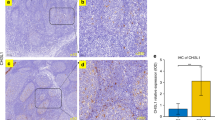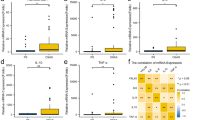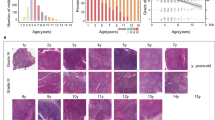Abstract
Adenotonsillar hypertrophy is the major pathophysiological mechanism underlying obstructive sleep apnea (OSA) and recurrent tonsillitis (RI) in children. The increased expression of various mediators of the inflammatory response in tonsils of patients with OSA prompted our hypothesis that the enhanced local and systemic inflammation in children with OSA would promote tonsillar proliferation. Mixed cell cultures from tonsils recovered during adenotonsillectomy in children with OSA and RI were established, and proliferative rates were assessed. Cells were also cultured to determine the levels of proinflammatory cytokines and antioxidant protein levels and mRNA expression. Global cell proliferative rates from OSA tonsils were significantly higher than RI (p < 0.01), with CD3+, CD4+, and CD8+ cell proliferation being higher in OSA (p < 0.05). Moreover, proinflammatory cytokines, such as TNF-α, IL-6, and IL-1α, were highly expressed in OSA-derived tonsils. Furthermore, thioredoxin (TRX), an antioxidant protein, was also highly expressed in OSA tonsils at the mRNA and protein levels (p < 0.01). Thus, T cells are in a highly proliferative state in the tonsils of children with OSA and are associated with increased production of proinflammatory cytokines and TRX, when compared with children with RI.
Similar content being viewed by others
Log in or create a free account to read this content
Gain free access to this article, as well as selected content from this journal and more on nature.com
or
Abbreviations
- AHI:
-
Obstructive Apnea Hypopnea Index
- BrdU:
-
bromodeoxyuridine
- OSA:
-
obstructive sleep apnea
- RI:
-
recurrent infection
- TRX:
-
thioredoxin
References
Lumeng JC, Chervin RD 2008 Epidemiology of pediatric obstructive sleep apnea. Proc Am Thorac Soc 5: 242–252
Gozal D 1998 Sleep-disordered breathing and school performance in children. Pediatrics 102: 616–620
Chervin RD, Archbold KH 2001 Hyperactivity and polysomnographic findings in children evaluated for sleep-disordered breathing. Sleep 24: 313–320
Amin RS, Kimball TR, Kalra M, Jeffries JL, Carroll JL, Bean JA, Witt SA, Glascock BJ, Daniels SR 2005 Left ventricular function in children with sleep-disordered breathing. Am J Cardiol 95: 801–804
Gozal D, Kheirandish-Gozal L 2007 Neurocognitive and behavioral morbidity in children with sleep disorders. Curr Opin Pulm Med 13: 505–509
Kheirandish L, Gozal D 2006 Neurocognitive dysfunction in children with sleep disorders. Dev Sci 9: 388–399
O'Brien LM, Mervis CB, Holbrook CR, Bruner JL, Smith NH, McNally N, McClimment MC, Gozal D 2004 Neurobehavioral correlates of sleep-disordered breathing in children. J Sleep Res 13: 165–172
Capdevila OS, Kheirandish-Gozal L, Dayyat E, Gozal D 2008 Pediatric obstructive sleep apnea: complications, management, and long-term outcomes. Proc Am Thorac Soc 5: 274–282
Gozal D, Kheirandish-Gozal L, Serpero LD, Sans Capdevila O, Dayyat E 2007 Obstructive sleep apnea and endothelial function in school-aged nonobese children: effect of adenotonsillectomy. Circulation 116: 2307–2314
Katz ES, D'Ambrosio CM 2008 Pathophysiology of pediatric obstructive sleep apnea. Proc Am Thorac Soc 5: 253–262
Webb CJ, Osman E, Ghosh SK, Hone S 2004 Tonsillar size is an important indicator of recurrent acute tonsillitis. Clin Otolaryngol Allied Sci 29: 369–371
Schechter MS, Section on Pediatric Pulmonology Subcommittee on Obstructive Sleep Apnea Syndrome 2002 Technical report: diagnosis and management of childhood obstructive sleep apnea syndrome. Pediatrics 109: e69
Darrow DH, Siemens C 2002 Indications for tonsillectomy and adenoidectomy. Laryngoscope 112: 6–10
Boyd JH, Petrof BJ, Hamid Q, Fraser R, Kimoff RJ 2004 Upper airway muscle inflammation and denervation changes in obstructive sleep apnea. Am J Respir Crit Care Med 170: 541–546
Gozal D, Crabtree VM, Sans Capdevila O, Witcher LA, Kheirandish-Gozal L 2007 C-reactive protein, obstructive sleep apnea, and cognitive dysfunction in school-aged children. Am J Respir Crit Care Med 176: 188–193
Goldbart AD, Krishna J, Li RC, Serpero LD, Gozal D 2006 Inflammatory mediators in exhaled breath condensate of children with obstructive sleep apnea syndrome. Chest 130: 143–148
Li AM, Hung E, Tsang T, Yin J, So HK, Wong E, Fok TF, Ng PC 2007 Induced sputum inflammatory measures correlate with disease severity in children with obstructive sleep apnoea. Thorax 62: 75–79
Goldbart AD, Veling MC, Goldman JL, Li RC, Brittian KR, Gozal D 2005 Glucocorticoid receptor subunit expression in adenotonsillar tissue of children with obstructive sleep apnea. Pediatr Res 57: 232–236
Goldbart AD, Goldman JL, Li RC, Brittian KR, Tauman R, Gozal D 2004 Differential expression of cysteinyl leukotriene receptors 1 and 2 in tonsils of children with obstructive sleep apnea syndrome or recurrent infection. Chest 126: 13–18
Kaditis AG, Ioannou MG, Chaidas K, Alexopoulos EI, Apostolidou M, Apostolidis T, Koukoulis G, Gourgoulianis K 2008 Cysteinyl leukotriene receptors are expressed by tonsillar T cells of children with obstructive sleep apnea. Chest 134: 324–331
Goldbart AD, Goldman JL, Veling MC, Gozal D 2005 Leukotriene modifier therapy for mild sleep-disordered breathing in children. Am J Respir Crit Care Med 172: 364–370
Goldbart AD, Mager E, Veling MC, Goldman JL, Kheirandish-Gozal L, Serpero LD, Piedimonte G, Gozal D 2007 Neurotrophins and tonsillar hypertrophy in children with obstructive sleep apnea. Pediatr Res 62: 489–494
Montgomery-Downs HE, O'Brien LM, Gulliver TE, Gozal D 2006 Polysomnographic characteristics in normal preschool and early school-aged children. Pediatrics 117: 741–753
Montgomery-Downs HE, O'Brien LM, Holbrook CR, Gozal D 2004 Snoring and sleep-disordered breathing in young children: subjective and objective correlates. Sleep 27: 87–94
Livak KJ, Schmittgen TD 2001 Analysis of relative gene expression data using real-time quantitative PCR and the 2(-Delta Delta C(T)) method. Methods 25: 402–408
Giger B, Bonanomi A, Odermatt B, Ladell K, Speck RF, Kojic D, Berger C, Niggli FK, Nadal D 2004 Human tonsillar tissue block cultures differ from autologous tonsillar cell suspension cultures in lymphocyte subset activation and cytokine gene expression. J Immunol Methods 289: 179–190
Komorowska A, Komorowski J, Banasik M, Lewkowicz P, Tchorzewski H 2005 Cytokines locally produced by lymphocytes removed from the hypertrophic nasopharyngeal and palatine tonsils. Int J Pediatr Otorhinolaryngol 69: 937–941
McColley SA, Carroll JL, Curtis S, Loughlin GM, Sampson HA 1997 High prevalence of allergic sensitization in children with habitual snoring and obstructive sleep apnea. Chest 111: 170–173
Duchna HW, Rasche K, Lambers N, Orth M, Merget R, Schultze-Werninghaus G 1997 [Incidence of cutaneous sensitization to environmental allergens in obstructive sleep apnea syndrome]. Pneumologie 51: 763–766
Piedimonte G, Hegele RG, Auais A 2004 Persistent airway inflammation after resolution of respiratory syncytial virus infection in rats. Pediatr Res 55: 657–665
Piedimonte G, Rodriguez MM, King KA, McLean S, Jiang X 1999 Respiratory syncytial virus upregulates expression of the substance P receptor in rat lungs. Am J Physiol 277: L831–L840
Lipton AJ, Gozal D 2003 Treatment of obstructive sleep apnea in children: do we really know how?. Sleep Med Rev 7: 61–80
Tauman R, Gulliver TE, Krishna J, Montgomery-Downs HE, O'Brien LM, Ivanenko A, Gozal D 2006 Persistence of obstructive sleep apnea syndrome in children after adenotonsillectomy. J Pediatr 149: 803–808
Guilleminault C, Huang YS, Glamann C, Li K, Chan A 2007 Adenotonsillectomy and obstructive sleep apnea in children: a prospective survey. Otolaryngol Head Neck Surg 136: 169–175
Mitchell RB, Kelly J 2007 Outcome of adenotonsillectomy for obstructive sleep apnea in obese and normal-weight children. Otolaryngol Head Neck Surg 137: 43–48
Kaditis AG, Alexopoulos E, Chaidas K, Ntamagka G, Karathanasi A, Tsilioni I, Kiropoulos TS, Zintzaras E, Gourgoulianis K 2009 Urine concentrations of cysteinyl leukotrienes in children with obstructive sleep-disordered breathing. Chest 135: 1496–501
Kheirandish-Gozal L, Gozal D 2008 Intranasal budesonide treatment for children with mild obstructive sleep apnea syndrome. Pediatrics 122: e149–e155
Puig F, Rico F, Almendros I, Montserrat JM, Navajas D, Farre R 2005 Vibration enhances interleukin-8 release in a cell model of snoring-induced airway inflammation. Sleep 28: 1312–1316
Almendros I, Carreras A, Ramírez J, Montserrat JM, Navajas D, Farré R 2008 Upper airway collapse and reopening induce inflammation in a sleep apnoea model. Eur Respir J 32: 399–404
Series F, Chakir J, Boivin D 2004 Influence of weight and sleep apnea status on immunologic and structural features of the uvula. Am J Respir Crit Care Med 170: 1114–1119
Gozal D, Kheirandish L 2006 Oxidant stress and inflammation in the snoring child: confluent pathways to upper airway pathogenesis and end-organ morbidity. Sleep Med Rev 10: 83–96
Tauman R, Ivanenko A, O'Brien LM, Gozal D 2004 Plasma C-reactive protein levels among children with sleep-disordered breathing. Pediatrics 113: e564–e569
Khalyfa A, Capdevila OS, Buazza MO, Serpero LD, Kheirandish-Gozal L, Gozal D 2009 Genome-wide gene expression profiling in children with non-obese obstructive sleep apnea. Sleep Med 10: 75–86
Gozal D, Capdevila OS, Kheirandish-Gozal L 2008 Metabolic alterations and systemic inflammation in obstructive sleep apnea among nonobese and obese prepubertal children. Am J Respir Crit Care Med 177: 1142–1149
Alexopoulos EI, Kaditis AG, Kalampouka E, Kostadima E, Angelopoulos NV, Mikraki V, Skenteris N, Gourgoulianis K 2004 Nasal corticosteroids for children with snoring. Pediatr Pulmonol 38: 161–167
Hirota K, Nakamura H, Masutani H, Yodoi J 2002 Thioredoxin superfamily and thioredoxin-inducing agents. Ann N Y Acad Sci 957: 189–199
Kondo N, Nakamura H, Masutani H, Yodoi J 2006 Redox regulation of human thioredoxin network. Antioxid Redox Signal 8: 1881–1890
Yoshioka J, Schreiter ER, Lee RT 2006 Role of thioredoxin in cell growth through interactions with signaling molecules. Antioxid Redox Signal 8: 2143–2151
Perl A, Gergely P Jr Puskas F, Banki K 2002 Metabolic switches of T-cell activation and apoptosis. Antioxid Redox Signal 4: 427–443
Park AM, Suzuki YJ 2007 Effects of intermittent hypoxia on oxidative stress-induced myocardial damage in mice. J Appl Physiol 102: 1806–1814
Takahashi K, Chin K, Nakamura H, Morita S, Sumi K, Oga T, Matsumoto H, Niimi A, Fukuhara S, Yodoi J, Mishima M 2008 Plasma thioredoxin, a novel oxidative stress marker, in patients with obstructive sleep apnea before and after nasal continuous positive airway pressure. Antioxid Redox Signal 10: 715–726
Acknowledgements
We thank Kenneth R. Brittian for technical assistance with immunohistochemical procedures.
Author information
Authors and Affiliations
Corresponding author
Additional information
Supported by National Institutes of Health grants HL-065270, HL-086662, and HL-083075 (D.G.), the Commonwealth of Kentucky Research Challenge for Excellence Trust Fund (D.G.), the Children's Foundation Endowment for Sleep Research (D.G.), and an investigator initiated grant from Merck Company (L.K.G.).
Rights and permissions
About this article
Cite this article
Kim, J., Bhattacharjee, R., Dayyat, E. et al. Increased Cellular Proliferation and Inflammatory Cytokines in Tonsils Derived From Children With Obstructive Sleep Apnea. Pediatr Res 66, 423–428 (2009). https://doi.org/10.1203/PDR.0b013e3181b453e3
Received:
Accepted:
Issue date:
DOI: https://doi.org/10.1203/PDR.0b013e3181b453e3
This article is cited by
-
Association of preoperative neutrophil–lymphocyte ratios with the emergence delirium in pediatric patients after tonsillectomy and adenoidectomy: an observational prospective study
Journal of Anesthesia (2024)
-
Possible mechanism of CHI3L1 promoting tonsil lymphocytes proliferation in children with obstructive sleep apnea syndrome
Pediatric Research (2022)
-
Systemic corticosteroids could be used as bridge treatment in children with obstructive sleep apnea syndrome waiting for surgery
Sleep and Breathing (2022)
-
Haematologic Markers and Tonsil-to-Body Weight Ratio to Assist Adenotonsillar Hypertrophy Diagnosis
Indian Journal of Otolaryngology and Head & Neck Surgery (2022)
-
Association of chronic and acute inflammation of the mucosa-associated lymphoid tissue with psychiatric disorders and suicidal behavior
Translational Psychiatry (2019)



